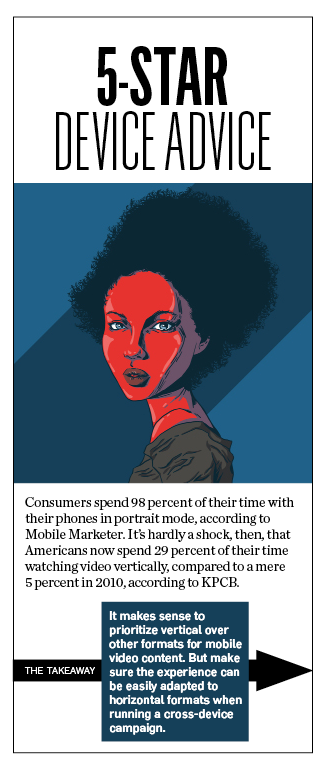Vertical video may have started out as a mobile anomaly, but Snapchat changed all that. Today, Snapchat users watch 10 billion videos a day on the app, up from 8 billion just three months ago. The question now is how long until horizontal video is more trouble than it’s worth for the user.
That day may come sooner than anyone thought. Advertisers and publishers are putting vertical to the test with creative executions on Snapchat Discover and across other vertical ad platforms. Emerging brands aren’t the only ones experimenting, either. Traditional outlets like MTV, ESPN and National Geographic have found new ways to enhance viewer experiences with vertical video. Here are some useful insights gleaned from their experiences:
 MTV focuses on intimacy and à la carte accessibility
MTV focuses on intimacy and à la carte accessibility
MTV is relaunching its celebrity home tour series “Cribs” as a Snapchat Discover channel. Instead of over-the-top showcases of the original, this version will feature intimate house tours recorded by the stars themselves on smartphones—a kind of behind-the-scenes access. MTV, which has had a Snapchat Discover channel since February, also greenlit a Snapchat series about sex and relationships called “Pants Off,” which will feature a new “auto-advance” technology enabling viewers to control the exact pieces of content they want to engage with.
This kind of à la carte, short-form video content takes advantage of vertical’s power. Successful videos on Snapchat turn the constraints of vertical into strengths. “Our viewers prefer vertical,” Snapchat’s head of content, Nick Bell, told USAToday last year. “We’ve seen a 9 times higher engagement rate with vertical rather than horizontal video.”
The right mix garners video completions for National Geographic
With its rich, image-focused legacy, National Geographic might not be the first brand you’d expect to embrace vertical. Yet it already offers a mix of short-form video, articles and photo-driven stories about travel and adventure on Snapchat Discover. In fact, vertical can work even better for mountainscapes and animal close-ups—a short video of a baby sloth has been a major hit. As National Geographic social media vp Raj Mody told The Los Angeles Times: “From day one, we saw this as a great way to reach new young audiences and advance our mission. We definitely think it’s showing promise.”
Tal Chalozin, co-founder and CTO of video platform Innovid, finds Snapchat’s video views and user engagement to be extremely high. He recommends publishers look at the completion rate to gauge impact, adding that many Snapchat videos are achieving 90 percent completion rates or above. “Snapchat is redefining the word premium,” says Chalozin. “People are willing to give their time to watch, regardless of the production value. But that specific term—completion rate—can be a great gauge for quality.”
ESPN focuses in
With traditional sports coverage going high-def and widescreen, ESPN is using vertical video to get up close with athletes in short, easily digestible clips. Rather than reusing a highlight reel that might be available on other channels, ESPN makes sure the videos on its Snapchat Discover channel focus on an individual’s performance and work well in the layout. For example, following the final game of an NBA player’s career, the network released a series of close-up videos of his 60-point performance.
Marketers can expect more vertical formats to emerge beyond Snapchat. For instance, the publisher Hearst is adding full-screen vertical video ads to its mobile ad mix. Programmatic video distributor Virool is planning a new vertical video ad unit. Others will be doing the same.
On mobile phones, vertical video just makes sense. And because viewer habits lean so heavily on vertical views, successful content creators are learning how to turn the restrictions of vertical into assets that produce new and interesting forms of entertainment.









